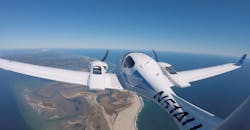Unmanned aircraft (UA) are quickly becoming integral tools in defense systems. On that front, Boeing recently conducted a flight experiment to test the use of airborne radars to work with the unmanned aerial system (UAS) onboard an unmanned aircraft. The flight experiment was conducted at the headquarters of Aurora Flight Systems, a subsidiary of Boeing located in Manassas, Va. The airborne radar was added to an Inexa Access Ground Detect and Avoid System from Insitu (www.insitu.com), a Boeing subsidiary. The radar helps create a common operating view for UAS operators to visualize local air traffic and keep an unmanned aircraft clear of nearby aircraft.
An autonomous and optionally piloted Aurora Centaur was equipped with a small radar system, serving as a UAS surrogate and providing similar functionality to Insitu’s ScanEagle3 aircraft system. To create real-world operating conditions, a second Aurora Centaur aircraft and a Cessna 172 aircraft were used as “intruder” vehicles within the same airspace. During the experiments, the other aircraft were flown on collision-type flight profiles to evaluate the response of the radar-equipped Aurora Centaur as well as record the data for analysis. Data from global positioning systems (GPS) onboard all three aircraft provided precise location information during the experiments.
“Boeing’s airspace access solution is already used around the world,” said Jim Bray, project manager. “This flight experiment adds a small airborne radar to improve the comprehensive safety case we can offer our customers.” Fortem Technologies developed the radar technology. Boeing has invested in Fortem, which is developing radar systems for both manned and unmanned aircraft.
About the Author
Jack Browne
Technical Contributor
Jack Browne, Technical Contributor, has worked in technical publishing for over 30 years. He managed the content and production of three technical journals while at the American Institute of Physics, including Medical Physics and the Journal of Vacuum Science & Technology. He has been a Publisher and Editor for Penton Media, started the firm’s Wireless Symposium & Exhibition trade show in 1993, and currently serves as Technical Contributor for that company's Microwaves & RF magazine. Browne, who holds a BS in Mathematics from City College of New York and BA degrees in English and Philosophy from Fordham University, is a member of the IEEE.

